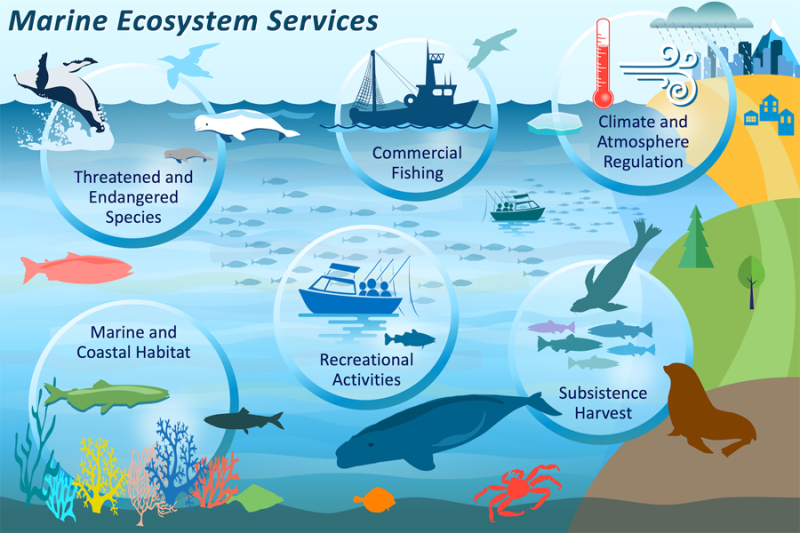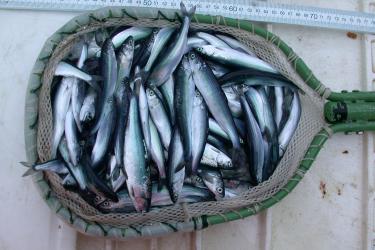Marine ecosystems provide myriad benefits to humans—from supplying food to tempering our climate to regulating the air we breathe. To use our oceans wisely, we need to understand the economic value of these “ecosystem services.”
A new nationwide NOAA study is the first to assess the validity of published studies that assigned economic values to U.S. marine ecosystem services based on public opinion surveys.
Economists use stated preference methods to derive economic values from how people respond to carefully worded questions in interviews or surveys. These methods are frequently used to estimate the value of ecosystem services that are not bought or sold in markets. The goal of the study was to evaluate the reliability of these estimates in the existing literature for use in fisheries and ecosystem assessments.
“For effective ecosystem-based fisheries management, we need to better understand the role of human activities and their associated economic values. We need to know that these values are valid to weigh the tradeoffs involved in different uses of the ocean. Our research contributes to this understanding,” said study leader Dan Lew, economist at the Alaska Fisheries Science Center. “But our findings have far broader applications. Many decisions by natural resource managers and policy-makers must be made quickly based on economic valuation data in the existing literature. They need to know if that literature is reliable.”
Economic Value of Ecosystem Services
Humans have always depended on ecosystem services. But the phrase was conceived only recently to describe the many benefits that ecosystems provide to people.
“Ecosystem services’ has exploded in popularity as a term and concept,” Lew said.
Knowing the economic value of an ecosystem service allows decision-makers to compare tradeoffs across different ecosystem services and human activities. It is a key part of ecosystem-based fisheries management approaches that have been employed in Alaska for the past couple of decades. It is also integral to NOAA’s integrated ecosystem assessments.
Economic values of ecosystem services can also be used to:
- Increase public awareness of the importance (from a monetary perspective) of an environmental service to society as a whole
- Track changes in the value of natural assets over time
- Design management programs involving payments for ecosystem services like user or access fees
- Set a project or program budget that does not exceed the value it would have for the public
- Inform natural resource damage cost determinations in legal settings
Providing a Dollar Value for Services that are Not Bought and Sold
The many services that marine ecosystems provide to humans fall into two economic categories: those that are bought and sold in markets, and those that are not.
Marine ecosystem services such as seafood are bought and sold in markets and can be valued by analyzing market transactions.
To estimate the value of ecosystem services that are not bought and sold in markets, economists often use stated preference methods. These methods estimate value from what people say about their preferences and values in responses to carefully constructed questions in interviews or surveys.
Marine ecosystem services that are typically valued using stated preference include:
- Recreational fishing
- Other marine and coastal recreational activities
- Marine protected areas
- Coastal and marine habitats
- Threatened and endangered species
How Well Has Stated Preference Research Followed Best Practices?
In 2017, experts developed 23 best practice guidelines for stated preference research to ensure the reliability of economic value information.
The new NOAA study provides a first assessment of how well U.S. marine ecosystem service valuations in the literature adhere to these guidelines.
“None of the studies we examined fully adhered to all of the best practice guidelines. But we found that valuations in the literature are improving and will likely continue to improve in the future,” Lew said. “So it is best to use more recent literature when conducting benefit-cost analyses.”
However, the study also identified areas for further improvement.
“For example, adherence to standards related to data confidentiality and informed consent of survey participants was pretty uniformly ignored in the literature we examined,” Lew said.
The study also found that most attention has been on only a small subset of ecosystem service values: coastal and marine recreation, and threatened and endangered species.
“We found that the current literature does a pretty good job overall. It’s a good starting point for understanding the economic benefits for some uses of marine ecosystems,” Lew said. “Our study provides some guidance for applying existing literature values, and for improving them in the future. It highlights the need for ongoing studies to both produce new economic value information and to adjust to best practices as they evolve.”
This research was a collaborative effort by NOAA’s Alaska Fisheries Science Center, Northwest Fisheries Science Center, Office of Science and Technology, and Northeast Fisheries Science Center.








